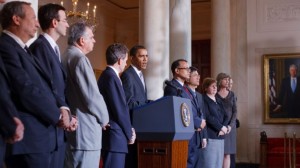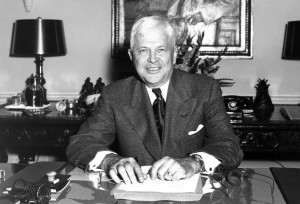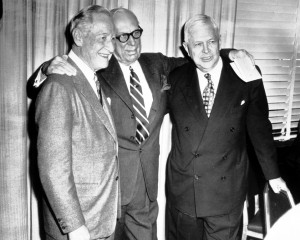
"And when that happens, we can truly say that what is good for General Motors and all who work there is good for the United States of America."
While the President was due to address the General Motors bankruptcy shortly before noon in the Grand Foyer of the White House today, he began his remarks by reviewing the situation at Chrysler. It was a skilful way to lead from the strength of a politician’s promises fulfilled, before making another very expensive set of promises, which were already under attack.
This was the second time in two months that the President devoted a significant amount of time to the auto industry, and it’s time that the president has said – more than once — he would rather be using doing other things.
He reminded an international audience that “These companies were facing a crisis decades in the making, and having relied on loans from the previous administration, were asking for more.”
“From the beginning, I made it clear that I would not put any more tax dollars on the line if it meant perpetuating the bad business decisions that had led these companies to seek help in the first place. I refused to let these companies become permanent wards of the state, kept afloat on an endless supply of taxpayer money. In other words, I refused to kick the can down the road,” he said.
It is precisely the criticism that once failed companies are put on taxpayer life support, there is no way to pull the plug, leading to endless spending during a prolonged deathwatch. For once President Obama resisted the opportunity to point out that the economic crisis was inherited after eights years of Republican leadership or that current Republicans have no plans to save jobs or strengthen the economy. He stayed with a message dear to his constituents:

Secretary of Defense Charles E. Wilson, aka Engine Charlie, at his desk in the Pentagon
“But I also recognized the importance of a viable auto industry to the well-being of families and communities across our industrial Midwest and across the United States. In the midst of a deep recession and financial crisis, the collapse of these companies would have been devastating for countless Americans, and done enormous damage to our economy — beyond the auto industry,” he said.
Change the President Can Believe in
Obama reiterated that the previous viability plans were rejected because they were fundamentally unsound, and that for government support to continue the companies would have convince him that they were making sweeping changes that he could believe in, a nice reversal on his successful Presidential campaign theme of last fall.
GM’s deadline to do so was today, but before addressing GM, Obama turned to Chrysler:
“When my administration took office and began going over Chrysler’s books, the future of this great American car company was uncertain. In fact, it was not clear whether it had any future at all. But after consulting with my Auto Task Force, industry experts, and financial advisors, and after asking many tough questions, I became convinced that if Chrysler were willing to undergo a restructuring, and if it were able to form a partnership with a viable global car company, then Chrysler could get a new lease on life,” he said.
Promises Fulfilled, Critics Wrong
“Today, after taking a number of painful steps, and moving through a quick, efficient, and fair bankruptcy process, a new, stronger Chrysler is poised to complete its alliance with Fiat,” said Obama. “Just 31 days after Chrysler’s Chapter 11 bankruptcy filing, a court has approved the Chrysler-Fiat alliance, paving the way for a new Chrysler to emerge from bankruptcy in the next few days.”
“And keep in mind — many experts said that a quick, surgical bankruptcy was impossible. They were wrong. Others predicted that Chrysler’s decision to enter bankruptcy would lead to an immediate collapse in consumer confidence that would send car sales over a cliff. They were wrong, as well. In fact, Chrysler sold more cars in May than it did in April, in part because consumers were comforted by our extraordinary commitment to stand behind a quick bankruptcy process. All in all, it’s a dramatic — an outcome dramatically better than what appeared likely when this process began,” Obama concluded.
GM is the Same but Different
“Now the situation we found at General Motors was very different from what we found at Chrysler — largely because GM is… much larger and much more complex, with operations all over the globe,” Obama said. “Working with my Auto Task Force, GM and its stakeholders have produced a viable, achievable plan that will give this iconic American company a chance to rise again,” he said.
The President then addressed the most difficult political issue that had arisen with GM’s plan – the use of taxpayer money to import vehicles from closed Asian markets:
“As this plan takes effect, GM will start building a larger share of its cars here at home, including fuel-efficient cars. In fact, if all goes according to plan, the share of GM cars sold in the United States that are made here will actually grow for the first time in three decades,” Obama claimed.
U.S. Industrial Policy Still Missing?
Here was an opportunity missed, though. Unemployment continues to rise and the Global economy continues to contract, as other nations continue to refuse to stimulate demand in their own markets and continue to restrict access to them, when are we going to have the debate about the obvious need for a U.S. industrial policy?
Instead the president went through a series of talking points that defended the broad outlines of the GM bankruptcy plan to all the groups getting hurt by it, claiming it is tough but fair:
— The United Auto Workers will make further cuts in compensation and retiree health care benefits.
— GM shareholders will give up the remaining value of their shares.
— Unsecured bondholders will recover more than the current value of their claims, and substantially more than they would have recovered if the government had not intervened and GM had liquidated.
“What we have, then, is a credible plan that is full of promise,” said Obama. “But GM can’t put this plan into effect on its own. Executing this plan will require a substantial amount of money that only a government can provide… the governments of Canada and Ontario have agreed to do their part with an investment in GM’s future, and I want to thank them for doing so. I also want to thank the government of Germany for working diligently to reach a Memorandum of Understanding on the sale of a major stake in GM’s European Division and for providing interim funding that will make it possible for that transaction to be finalized,” he said.
$50 Billion Bucks Stop Here
“But of course GM is an American company with tens of thousands of employees in this country, and responsibility for its future ultimately rests with us. That’s why our government will be making a significant additional investment of about $30 billion in GM — an investment that will entitle American taxpayers to ownership of about 60% of the new GM,” he said. U.S. taxpayers have already supplied $20 billion in aid.
Massive Taxpayer Investment Defended
Confronting the obvious criticisms, the President resorted to his usual and thus far successful “let me patiently explain” style:
“I recognize that this may give some Americans pause. So let me explain as clearly as possible why we are making this investment. We inherited a financial crisis unlike any that we’ve seen in our time. This crisis crippled private capital markets and forced us to take steps in our financial system — and with our auto companies — that we would not have otherwise even considered. These steps have put our government in the unwelcome position of owning large stakes in private companies for the simple and compelling reason that their survival and the success of our overall economy depend on it.
“Understand we’re making these investments not because I want to spend the American people’s tax dollars, but because I want to protect them. Instead of taking so much stock in GM, we could have simply offered the company more loans. But for years, GM has been buried under an unsustainable mountain of debt. And piling an irresponsibly large debt on top of the new GM would mean simply repeating the mistakes of the past. So we are acting as reluctant shareholders — because that is the only way to help GM succeed,” he concluded.
Running for Office, Not Running GM
“What we are not doing — what I have no interest in doing — is running GM. GM will be run by a private board of directors and management team with a track record in American manufacturing that reflects a commitment to innovation and quality. They — and not the government — will call the shots and make the decisions about how to turn this company around,” Obama promised.
“In short, our goal is to get GM back on its feet, take a hands-off approach, and get out quickly,” Obama said.
New GM has Costly Human Toll
“But I want to be honest with you. Building a leaner GM will come at a cost… So I want to say a word directly to all the men and women watching today, wondering what all of this will mean as far as their own lives are concerned.

It was at his confirmation hearings for Secretary of Defense in 1953 that Wilson, then CEO of GM, was asked if he could ever make a decision that was bad for GM. Curtice replied yes, but then rejected the premise entirely with the now famous, "because for years I thought what was good for the country was good for General Motors and vice versa."
“I know you’ve already seen more than your fair share of hard times. We saw 400,000 jobs lost in the auto industry in the year before this restructuring even began. I will not pretend the hard times are over. Difficult days lie ahead. More jobs will be lost. More plants will close. More dealerships will shut their doors, and so will many parts suppliers.
“But I want you to know that what you’re doing is making a sacrifice for the next generation — a sacrifice you may not have chose to make, but a sacrifice you were nevertheless called to make so that your children and all of our children can grow up in an America that still makes things; that still builds cars; that still strives for a better future.”
Engine Charlie’s Words Echoed
“I recognize that today’s news carries a particular importance because it’s not just any company we’re talking about — it’s GM. It’s a company that’s not only been a source of income, but a source of pride for generations of autoworkers and generations of Americans. But while the GM of the future will be different from the GM of the past, I am absolutely confident that if well managed, a new GM will emerge that can provide a new generation of Americans with a chance to live out their dreams, that can out-compete automakers around the world, and that can once again be an integral part of America’s economic future. And when that happens, we can truly say that what is good for General Motors and all who work there is good for the United States of America,” the President concluded.
